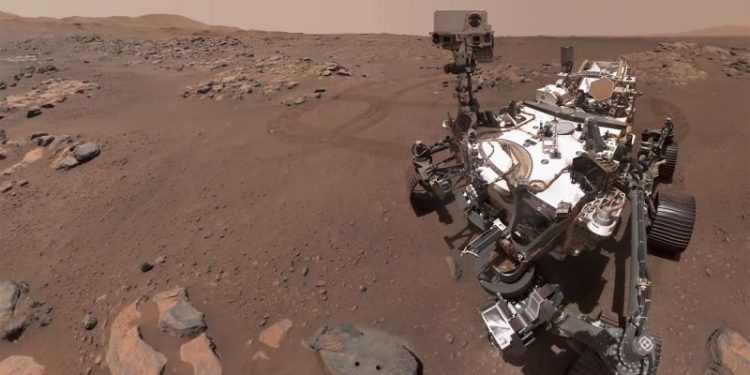Two new potential strategies for returning crucial samples from Mars to Earth by the 2030s are now on the table, according to NASA.
The proposals present alternatives to the original Mars Sample Return program. Designed by NASA and the European Space Agency, the initial plan was deemed unwieldy after an independent review board projected it could cost up to $11 billion. The board’s assessment also pushed the expected return date of the samples from 2031 to 2040 — a delay that was “simply unacceptable,” NASA Administrator Bill Nelson reiterated Tuesday.
The agency will decide between the newly proposed strategies, intended to reduce complexity, cost and mission duration, by the second half of 2026, Nelson announced during a news conference on Tuesday.
The NASA Perseverance rover has been gathering rocks and dust since it landed on Mars in February 2021. Scientists believe those samples — collected from Jezero Crater, the former site of an ancient lake and river delta — might be one of the only ways to determine whether life ever existed on the red planet.
But returning the specimens to Earth, a feat that could answer one of humanity’s biggest questions about the potential for life beyond Earth, is a complex process. Both the original and new architecture for the program include multiple spacecraft that would be used to land on Mars and ferry the cache back to our planet.
In April, NASA asked its various centers and industry partners to come up with new plans for getting the samples back to Earth in a more streamlined and cost-effective way. The agency’s Mars Sample Return Strategic Review team assessed 11 of the studies and made recommendations to NASA, which were then further refined by leadership.
“We are exploring two new landing options,” said Dr. Nicky Fox, associate administrator for NASA’s Science Mission Directorate. “One is to leverage technology that was previously used to land both (the) Perseverance and Curiosity (rovers) on Mars. The other is to leverage options from industry.”
The first option will rely on the sky crane method, used for the entry descent and landing of the two rovers still exploring Mars. The second will utilize new commercial capabilities and partners to deliver a “heavy-lift vehicle” lander, such as designs from companies from SpaceX and Blue Origin, to Mars, Nelson said.
Mars has long posed a challenge to landers because its thin atmosphere is thick enough to burn up a spacecraft that isn’t tucked within an outer structure sporting a protective heat shield. But the red planet’s atmosphere is also too thin to rely on parachutes alone to slow down and create a safe landing.
For the deployment of the hefty car-size rover Curiosity, engineers created a system called the sky crane to secure the rover during entry, descent and landing. During the initial descent, a heat shield, parachute and retrorockets slowed down the spacecraft.
Then, the sky crane lowered the rover to the surface of the red planet using a strong cable. Afterward, the sky crane disconnected and crash-landed away from the site. In 2021, the same design was used to land Perseverance, and the team was actually able to capture video of the daring descent.
Mars sample return: The path ahead
The agency will proceed with testing the viability of both options and working through the engineering challenges of each plan over the next year at NASA’s Jet Propulsion Laboratory in Pasadena, California.
The newly proposed strategies provide the potential to return the samples to Earth as early as 2035, or as late as 2039, and with costs that range from $5.5 billion to $7.7 billion — a “far cry” from the original figure, Nelson said.
“Pursuing two potential paths forward will ensure that NASA is able to bring these samples back from Mars with significant cost and schedule saving compared to the previous plan,” Nelson said. “These samples have the potential to change the way we understand Mars, our universe, and — ultimately — ourselves.”
Ultimately, President-elect Donald Trump’s incoming administration will be responsible for requesting an appropriate budget to support the program — and deciding whether they wish to continue with the program at all, Nelson added.
Nelson said he has not discussed the new Mars sample return proposals with Jared Isaacman, the tech billionaire and spaceflight trailblazer Trump has picked to helm NASA, because all discussions are being handled by the transition team, he said.
“But I think it was a responsible thing to do to not hand the new administration just one alternative if they want to have a Mars sample return, which I can’t imagine that they don’t,” Nelson said.
Previously, China has declared an interest in also returning samples from Mars. The country’s Tianwen-3 mission might launch in 2028 to retrieve the Martian samples, which could be returned to Earth by 2031, although officials previously shared that they may also launch by 2030.
“I don’t think we want the only sample return coming back on the Chinese spacecraft, and that’s just simply a grab and go kind of mission,” Nelson said. “Whereas ours has been a very methodical process … to find different samples of different layers showing different ages of material and rocks, and when we bring back those 30 samples, it’s going to give quite a history of what Mars was like millions of years ago when there was water in the lake. And the big question: Was there life millions of years ago?”






